Method 2 -- Solid Freezing with Drilled Well
|
Milky-translucent look of a quick-frozen ice luminaria. |
| If the weather doesn't cooperate for the Winter Solstice luminarias, we're usually freezing 40 to 60 five-gallon buckets, so we need to beg for donated space a big walk-in commercial freezer, where we are not allowed to control the temperature. At minus 35 or 40 degrees, forty five-gallon buckets of water stacked to allow for good air circulation will freeze solid in 16 hours or less. | |
A solid-frozen block of ice can be drilled to make the candle well using a rotary ice-fishing auger. If you live in Wisconsin, you likely either own one or know someone who does. |
Drilling the candle well is exactly the same as drilling a hole in a frozen lake, except that you must brace the luminaria carefully, proceed slowly to center the auger carefully and then drill with a light touch to avoid splitting the ice block. |
We favor a small diameter (4 inch) auger, with very sharp blades. Drill the well as deep as you like; half- to two-thirds- of the way into the block is usually sufficient to make an attractive luminaria, |
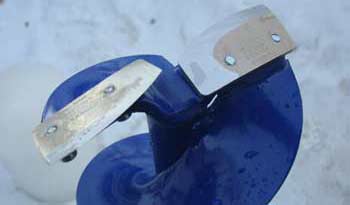 |
|
There are both aesthetic and practical concerns in choosing candle types. With clear ice the candle will be visible, so color and shape are important. With milky ice however only a glow is visible, so the candle's appearance is relatively unimportant. We've discovered that the largish open "mouth" of our luminarias does not do a very good job of protecting a candle flame from wind. So your candles may need additional protection, depending on diameter and depth of the candle well, the location of the luminaria and wind conditions. Some candles sold in glass jars work fine. However, we've found that some candles sold in glass, when used repeatedly in luminarias, seem to absorb small amounts of water into the wick itself (condensation on the surrounding glass? meltwater? drizzling or falling snow?) which causes them to "sizzle" and sputter and become difficult to ignite and keep lit even when they appear initially to be bone-dry and fine. For mild conditions, we've had success with an inexpensive tea candle at the bottom of a tall mason jar. There are several reasons for this:
|
|
Use a long-snouted butane lighter to light the candle. A typical tea candle will burn approximately 3 to 4 hours. |
(left) The preferred candle choices. 2-gallon bucket compared to a 5-gallon (bleow) Appearance comparison of ice types: slow-frozen, crystalline, self-well (2-gallon, left) vs. quick-frozen milky, drilled well (5-gallon, right), using the same candles.
|
|
In unpredictable wind and/or snowfall conditions, keeping the candles described above lit can be impossible. In 2009 we tackled the problem in a systematic way and came up with a very wind- and water-resistant design. |
|
Decanting When sufficiently frozen, turn the bucket upside-down and allow the ice block to slide out. Naturally-frozen ice (Method 1) will often release with some firm pushing on the bottom of the bucket. In contrast, solid-frozen ice (Method 2) is fully "expanded" and hard; you will likely need to warm the sides of the bucket to release the ice. For 5-gallon buckets outdoors we use a garbage can with about 10 to 12 inches of warm water; 10 to 30 seconds soaking is often enough. A 2-gallon bucket at home will typically fit in the kitchen sink. Check each bucket before decanting to make sure it is sufficiently frozen -- do not assume that all your attempts will have frozen at the same rate. For example, a bucket towards the center of a group will tend to freeze more slowly than those on the edges (unless you've allowed some sun to reach the sides of the naturally-frozen outer ones, in which case the reverse is true!). Handling Handle the ice gently, especially thin-walled naturally-frozen blocks,. Never carry them by the sidewalls -- always cradle them under the thick bottom. Avoid touching luminarias together; even a slight knock may be enough to crack the ice. Decanting is a wet business -- to handle the ice confidently and comfortably, we wear long rubber gloves with fabric lining or inner gloves for warmth. |
Repairs If a luminaria breaks in handling, all is not lost. Ice can be repaired with pressure. You can prove this: take two ice cubes in your hands and squeeze them together. They will creak and then bond -- the pressure creates enough heat to melt a little water at the joint, which re-freezes when the pressure is released. With care, the same technique can be used on an ice luminaria that have largish, intact pieces. Carefully support the pieces and then press to bond them just enough to look whole. And as we learned during one distressingly warm Solstice celebration, even imperfect, falling-apart ice luminarias can be quite beautiful.
|
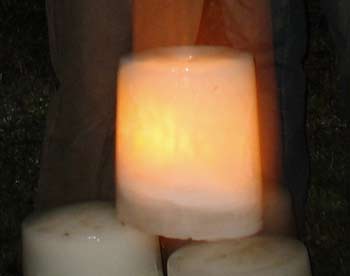
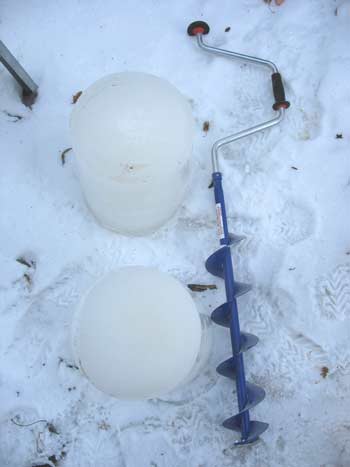

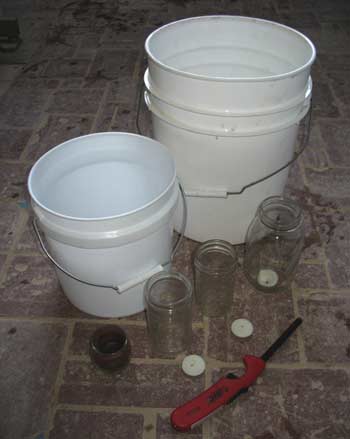

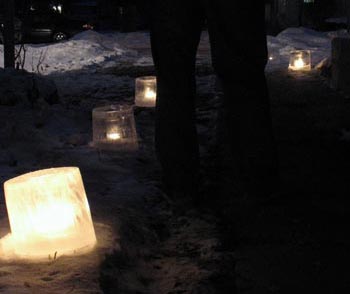
 Comments? lou@designcoalition.org
Comments? lou@designcoalition.org